Why do teachers often ask students to write a narrative essay in college?
Narrative essays are about storytelling. It’s the only instrument that makes people want to listen and remember what others say. If you wish to evoke emotions and influence decisions, learn how to build narratives.
This ultimate guide will reveal the concept of storytelling. You’ll learn how to choose topics, structure, and format for stories. After reading, you’ll know how to write a good narrative essay that wows readers.
Narrative Essay Definition
Narrative can serve as a synonym for storytelling (1). It’s about a particular format and elements to include in your text so it becomes a story.
In academia, a narrative essay definition is more specific.
Let’s Find Out What Is a Narrative Essay
A narrative essay is a piece of writing where a student tells a personal story using a storytelling format and all the characteristics of narrative writing.
What is the Purpose of a Narrative Essay?
The purpose of a narrative essay is to share views and make the readers see the world through an author’s eyes. You use a story format to tell about something. At the same time, you make a point for the audience to understand why this story is critical to share.
By making people listen to your story, you help them broaden their minds and become more creative with their experiences.
The purpose is to guide the audience. You don’t try persuading them, and you don’t criticize anything. You don’t look for arguments to prove your point of view. Instead, you tell a story to inform readers and allow them to draw their own conclusions.
How does narrative differ from expository writing?
| Narrative writing | Expository writing |
| Rely on a story to prove your thesis | Rely on research to prove your thesis |
| Descriptive, backed with feelings and emotions | Formal, backed with facts and evidence |
In narrative essays, the author tells a story and relies on it to prove a thesis statement. Expository essays provide research and rely on evidence to support a thesis.
Expository essays are more formal and fact-based. Narratives are more descriptive and backed with emotions and personal feelings.
Common Types of a Narrative Essay
Narrative essays come in different forms. In college, your two common narratives are descriptive and personal. The latter is an essay about yourself.
- Personal narrative. A focus is on your personality and inner world. You tell a story about a unique experience like overcoming fear, and you reflect on it. Example: When you faced a hard decision and how you handled it.
- Descriptive narrative. A focus is on the story. You tell how characters and surroundings look and feel, describing them. As a narrator, you don’t show your emotions or reflections. The goal is a reader’s total immersion in your described world. Literature example: The Tell-Tale Heart (Edgar Allan Poe).
| Descriptive narrative | Personal narrative | |
| Purpose: | Describe (a place, a person, a thing, etc.) | Narrate (experience, incident) |
| View: | The first or third person | The first person |
| Literary elements: | Plot, setting, characters | Plot, setting, characters |
Personal and descriptive narratives can also come in several forms:
- Literacy narrative. You tell about some reading, writing, or conversation experience and how it influenced your life. Example: The impact of a personality or a film on your life.
- Viewpoint narrative. You tell a story from the character’s point of view, describing inner worlds and reflections. Literature example: The Catcher in the Rye (J. D. Salinger).
- Historical narrative. A focus is on a specific period of your (character’s) life. Known as a memoir, it may center around a struggle, relationship, etc. Example: A meeting with a stranger that impressed you.
- Fictional narrative. It’s a made-up story built with classic storytelling elements. Examples: Sci-fi, romance, thriller, and other stories you find in books.
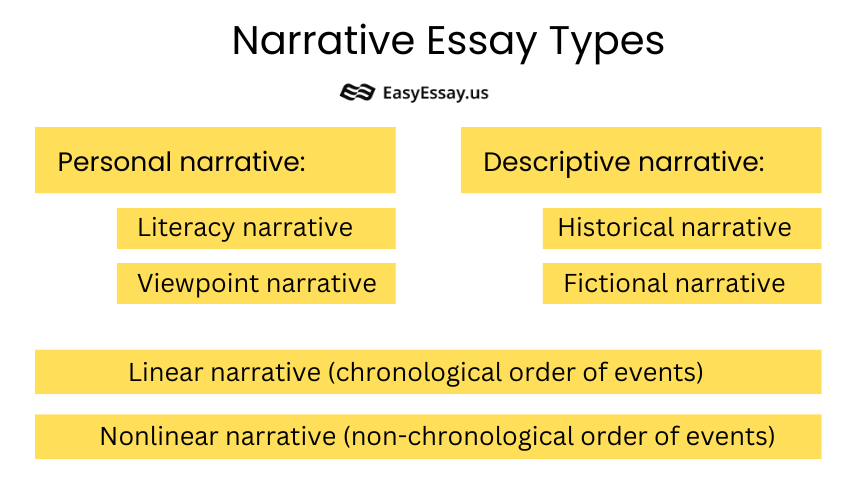
When it comes to structuring your story, two types of narrative exist. Depending on how you decide to order its elements, your essay can be:
- Linear narrative: A story is chronological, and every next scene continues the previous one. A movie example is Lion King.
- Nonlinear narrative: A story is non-chronological. You reshuffle the order of events to emphasize a character’s emotions or actions. Examples: It by Stephen King or Slaughterhouse-Five by Kurt Vonnegut.
Narrative Elements
How to make a narrative essay? As well as any other writing type, narrative essays have some specific characteristics:
- Characters: It can be a narrator (you), or you can create a protagonist. Other characters can also be there to interact (or not) within a story.
- Plot: It’s a series of events happening in your story. The plot can be simple and linear, telling about one event, or complex and nonlinear.
- Descriptive language: Authors use literary techniques to evoke emotions.
- Narrative structure: It’s how a character goes to the goal and faces the challenges. The standard narrative has three parts. It’s the beginning (exposition), the middle (a rising action, conflict, and a climax), and the end (a falling action and a conflict resolution).
Every narrative should have these four to become a story. Most authors use a narrative arc to combine all the elements into a writing piece:
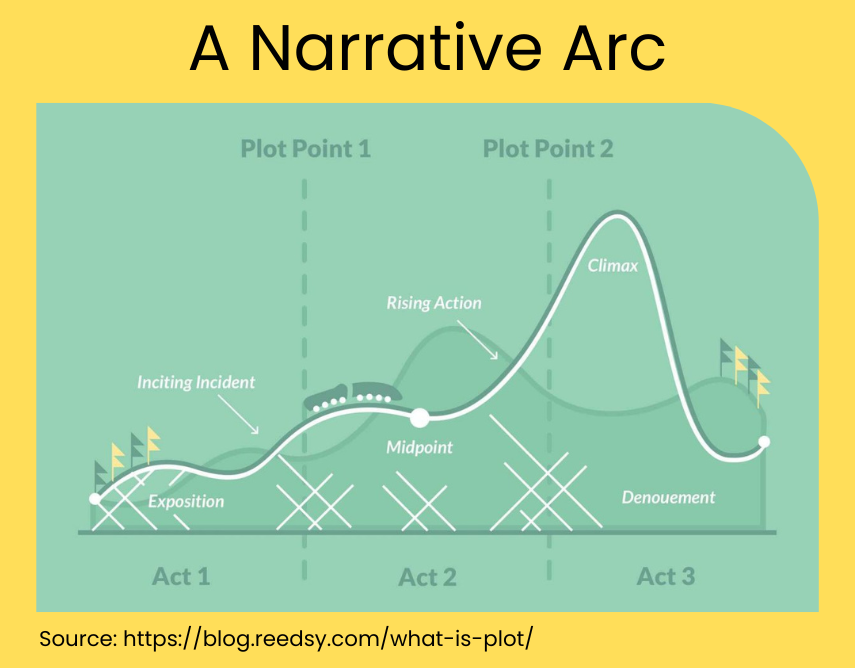
- Exposition — the intro with background information about your characters and setting
- Rising action — the trigger creating conflict and tension
- Climax — the main event when a character faces the truth, needs to make a choice, etc.
- Falling action — the result of that choice, the conflict resolution
- Resolution — the conclusion of your story, the moral you want to share
How to Start a Narrative Essay
Here’s how to begin your narrative essay. (Spoiler: Don’t hurry up to start writing a draft!)
Choose your topic
If you get particular prompts from teachers, skip this step. If you’re a student who didn’t get any topic for a narrative essay, consider brainstorming:
Take a seat, a pen, and paper, and think of what you’d like to tell others. Freewriting is a great technique that can help here.
Write down all thoughts that bother you, and list all the ideas that come to your mind. After that, re-read them and decide if any could work as a narrative essay topic.
Consider topics that are interesting, thought-provoking, and appealing to the audience. Social media and online communities can help you see what your peers discuss and share:
- What bothers society now?
- What message could you communicate with an essay?
Do you need any ready-made narrative topic ideas? Here they go!
Structure your story
Narrative essays are about personal experiences or fictional events. You won’t need any specific research to support your story with references.
But:
It’s critical to structure your essay. You need to ensure it will have all the narrative elements: characters and a plot with exposition, climax, and resolution. Think about how to make your essay a complete story. Decide on the claim (thesis) and the moral of your story for readers.
Outline your narrative
So, now you have a topic and an approximate plot for your narrative. Outline it before writing to see if you have enough details to communicate that claim to readers.
What is a narrative essay outline?
An essay outline is a map of your future story, showing the points each paragraph will contain (2).
What will you write about in each part of your essay? Craft a plan to avoid gaps that can hurt its clarity, and reorganize the story’s structure if necessary.
Also, mention supporting details in the outline to reinforce the claim.
Do you need a template for your narrative essay outline? Here it goes!
Narrative Topic Ideas
While teachers assign specific titles for narrative essays, they often allow choosing yours. And here the challenge comes:
You sit and stare at the screen, unable to craft a worthy story idea.
It often happens to me, so I know the risks. When stuck but chained with due dates, it’s tempting to take the first topic coming to mind.
Don’t do that!
A topic is essential for your story’s success. It should follow several criteria:
- Meaningful
- Relevant to your audience
- Thought-provoking
- Based on a specific moment or experience
- Resonant
You can use writing prompts for inspiration or check favorite blogs for topic ideas. Here go the niches to consider:
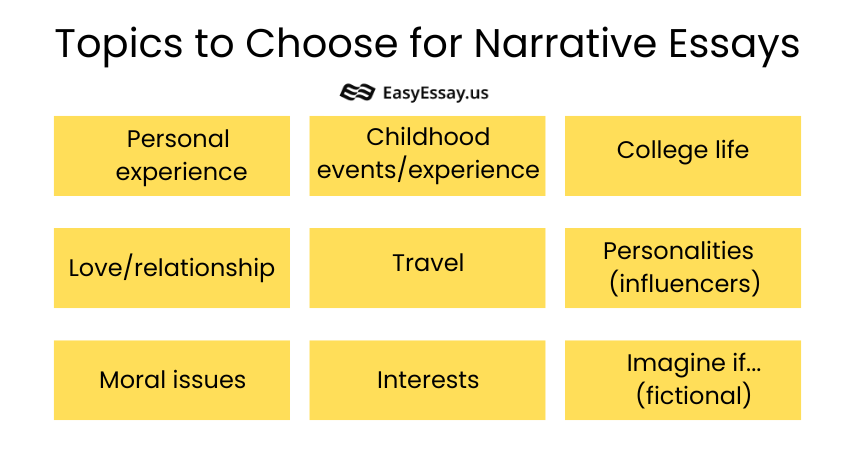
I’ve crafted a few samples of narrative essay topics for your inspiration. Here go the examples:
- The day you faced your biggest fear and overcame it.
- A life-changing decision you made and its impact on your life.
- The most memorable travel experience you’ve had.
- The day you met someone who influenced you.
- A childhood memory that still makes you smile.
- The first time you left the comfort zone and discovered something new about yourself.
- A time when you had to stand up for what you believed in, even in the face of opposition.
- The experience of participating in a significant community service project.
- A moment when you’ve realized the power of perseverance and determination.
- The day you experienced a cultural or religious tradition different from yours.
- An encounter with failure that taught you valuable life lessons.
- The story of a unique friendship that has shaped who you are today.
- An achievement that required your immense dedication and hard work.
- The most memorable family gathering you have attended.
- A time when you made a hard moral or ethical decision.
- The day you discovered a new passion that has become an integral part of your life.
- A memorable encounter with a stranger who left a lasting impression.
- The experience of overcoming a primary challenge in your life.
- A moment when you felt inspired by something.
- The day you realized the importance of gratitude and counting your blessings.
Structure Your Narrative Essay
I’ve already mentioned the narrative structure when told about a story’s elements. Let’s dive into the details! Below you’ll read about the exposition, climax, and conflict resolution.
In a narrative format essay, exposition comes in an introductory paragraph; rising action, climax, and falling action appear in essay body paragraphs; resolution comes in the conclusion.
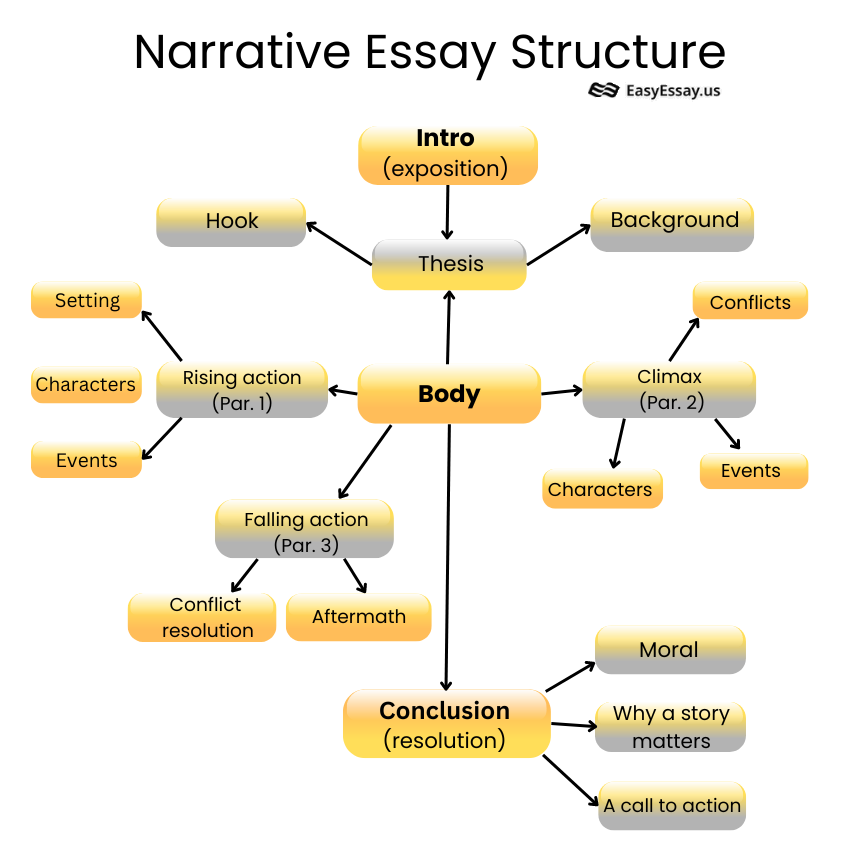
Start with your story’s setting. Then go to the main event with the climax, and finish with a conflict resolution and the moral. Remember the narrative arc: It guides you on how to hold the audience’s attention till the end.
Pay attention to the details. Remember to use descriptive language! Readers weren’t in your story, and they didn’t know how everything looked and felt there. So, help them imagine and “paint” the picture in their mind.
Below are the practical tips on writing each element of a narrative essay:
Exposition: Give the Context of a Story
Here’s how to begin a narrative:
The first paragraph is an exposition. Develop the context here, providing the setting and background. The goal is to make readers understand what will be in your story.
When writing, answer the following questions:
- What event do you want to describe?
- Where and when did it happen? (Give the context of place and time.)
- Does this context help readers understand the meaning of your narrative essay?
- Does it establish initial expectations for readers that you’ll develop through the story?
Plot: Analyze Cause and Effect
A plot is about the sequence of events happening in your story. It should have a clear structure and a conflict (problem) your protagonist overcomes.
In classical storytelling, authors base a plot on Joseph Campbell’s Monomyth (3):
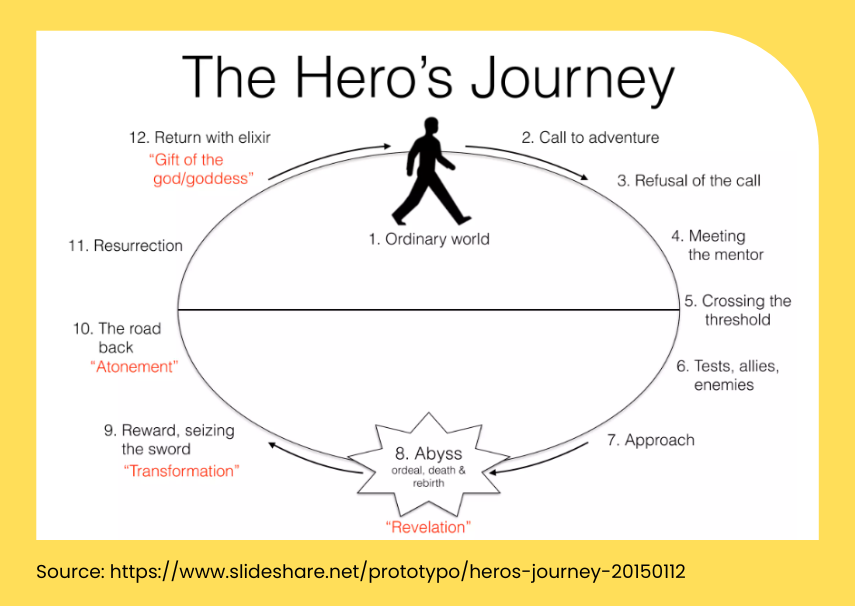
In narrative essays, you can use the same principle or, rather, its simplified version. Answer the following questions:
- What did happen before the described event that led to it?
- What happened right after the event?
- What was the result? Did anything change after the event?
- How has the described event influenced you (the protagonist)?
Characters: People in Your Story
Characters are a must-have narrative element, driving your story. You can’t tell it without anyone in the plot. Think of a narrator (you) or create a protagonist. Supporting personalities can also help, but ensure they are well-developed.
Answer these questions when creating your characters:
- Who is in the story besides you (the protagonist)?
- Why are they essential for your storyline?
- What is your relationship with each of those individuals?
- How do they take part in the conflict?
- Who is static, and who is dynamic in your story? Will your characters talk to each other?
Conflict (Climax): Highlight the Central Meaning
The climax is the turning point of your story. It’s when the protagonist faces the truth, makes a choice, etc. It’s the highest tension leading to a resolution in your essay’s conclusion.
Answer the following questions to develop the climax:
- When (at what point) in the story did you understand that transformation happened?
- What did you (the protagonist) reveal in the moment of truth?
Conclusion: How to End a Narrative Essay
The final paragraph is about the conflict resolution in your story. Here you provide the moral (thesis/argument you wanted to communicate).
Answer these questions to provide a stellar closure for your narrative:
- How did you (the protagonist) resolve the conflict? (Or, to what extent?)
- What lesson did you learn?
- Why does your story matter? (What can readers take from it?)
Follow these guidelines to create an engaging structure for your narrative essay. It’s your instrument to grab the reader’s interest and make them feel part of the story.
Narrative Essay Outline
Here’s a narrative essay outline template you can use. Fill it in, and it will be much easier and faster to write a draft:
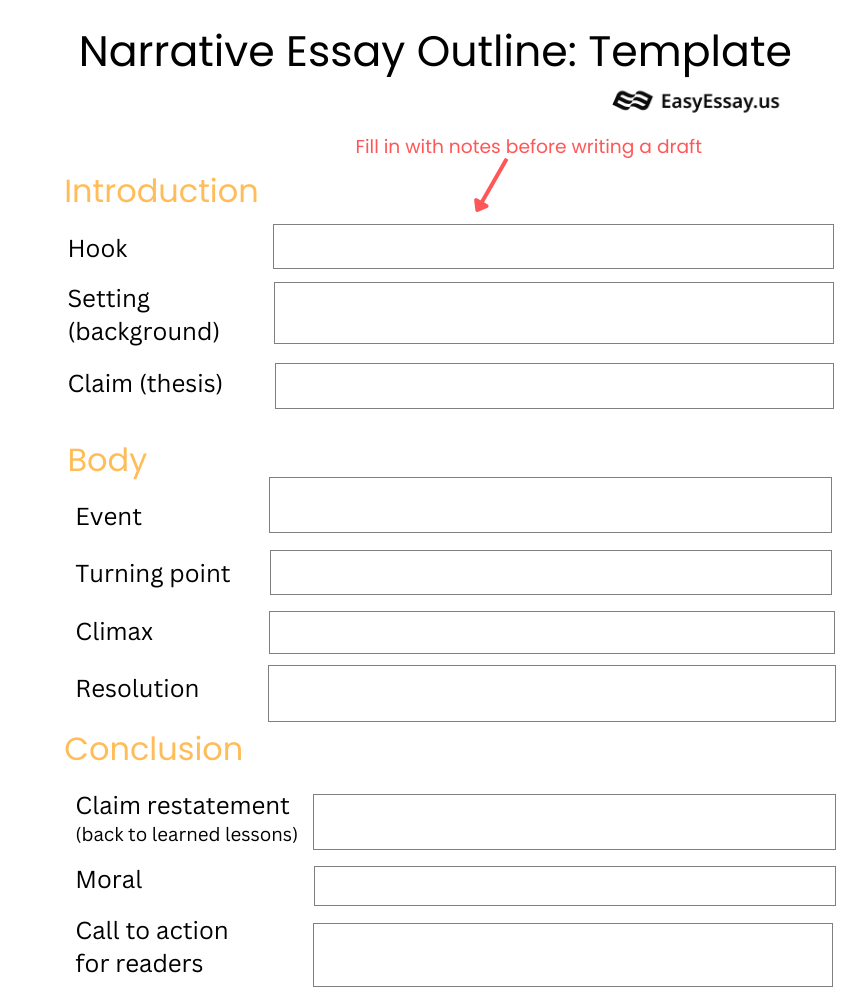
Below are the tips on what to write in every part of your essay. Ensure you mention supporting details to reinforce the claim and make a story.
Introduction
1. Hook: Write the first sentence of your story to grab the interest. Make it compelling so that they want to continue reading your story.
Narrative essay hooks are many. You can start with a relevant question, a thought-provoking statement, or an anecdote.
Extra Read: How to Write a Catchy Hook for an Essay: Types, Examples, and Tips
2. Background: Provide the setting for your story, such as the context of place and time. Introduce the characters.
3. Claim: It’s the thesis statement of your essay. State the main point of your story and preview the event(s) you’ll describe.
A narrative essay introduction example:
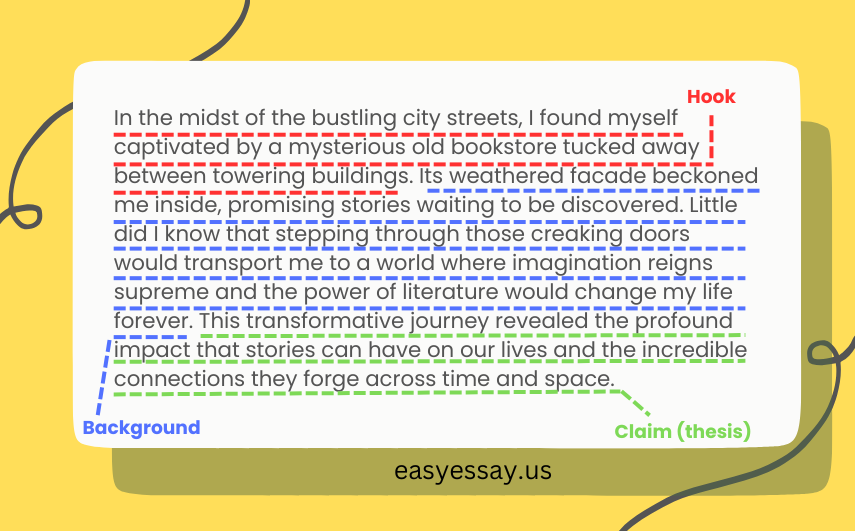
Body
1. Event(s): Tell about the situation(s) leading to the main event. Consider details about the setting and characters with their actions. Structure a storyline so it moves the plot.
2. Turning point: Describe the moment that led to conflict. What unexpected or significant happened that changed the course of events?
3. Climax: Tell about the story’s highest tension (conflict).
4. Resolution: Describe how you resolved the conflict. What lessons have you learned?
Conclusion
1. The claim restatement: Summarize your thesis and say how your story supports it. Go back to learned lessons again: What’s your transformation?
2. Moral: Reflect on the significance of your described experience. What should readers remember about your story? Why should they care?
3. Call to action: Complete your narrative with the final statement. You need to leave readers with food for thought. Give them something to consider or remember after reading your story.
A narrative essay conclusion example:

Popular Questions About Narrative Essay
And now, to the questions students like you often ask me in college:
What is the purpose of dialogue in a narrative essay?
Dialogues in a narrative essay drive the plot and reveal the characters’ motivations. One phrase from a character can say much more than a lengthy paragraph. Dialogues highlight emotions, build suspense, and communicate tension. They bring readers closer to a story’s climax and conclusion.
How long should a narrative essay be?
Most samples and prompts prescribe 500-600 words, while some need about 1,000 words. The word count depends on the institution assigning an essay. Unless otherwise stated, make your narrative essay as long as you need. One to five pages are the best option.
How many paragraphs are in a narrative essay?
A standard mla format narrative essay has five paragraphs. One paragraph goes for an introduction, three — for an essay body, and the last is for a conclusion. The first two body paragraphs describe the setting and events that lead to a climax. The third body paragraph tells about the conflict and its resolution.
How to format a narrative essay?
In a narrative format essay, exposition comes in an introductory paragraph. A rising action, climax, and falling action appear in the essay’s body paragraphs. The resolution comes in an essay conclusion. Follow a narrative essay structure to craft a story your readers will love and remember.
Over to You
So, here it goes, your detailed guide on how to write a narrative essay. Now that you know all the elements to include in a compelling story, it’s time for practice:
- Choose a thought-provoking topic.
- Decide on a narrative essay type: Will it be personal or descriptive?
- Structure your story using a narrative essay outline and including all narrative elements.
- Write a story, leaving readers with food for thought.
And before you get a narrative essay assigned, why not write a short story on your Instagram today?
References:
Hello just wanted to give you a brief heads up and let you know a few of the pictures aren’t loading properly. I’m not sure why but I think its a linking issue. I’ve tried it in two different web browsers and both show the same results.
You can create interest in any topic! Bravo!